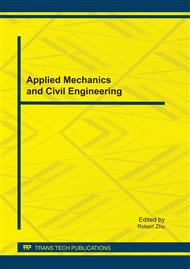[2]
L. Brennan P. Owende, Biofuels from microalgae-A review of technologies for production processing and extractions of biofuels and co-products, Renewable and Sustainable Energy Reviews. 2 (2010) 557-577.
DOI: 10.1016/j.rser.2009.10.009
Google Scholar
[3]
S. Behzadi, M.M. Farid, Review: examining the use of different feedstock for the production of biodiesel, Asia-Pacific Journal of Chemical Engineering. 2 (2007) 480-486.
DOI: 10.1002/apj.85
Google Scholar
[4]
H.Y. Hu, X. Li, Analysis of key techniques and production potential of biodiesel production based on microalgae with wastewater as resources, Ecology and Environmental Sciences. 3 (2010) 739-744.
Google Scholar
[5]
C. Wang H. Li P. Wei, Study on microbial oil production with Chlorella cultured in biogas slurry, Chinese Journal of Environmental Engineering. 8 (2010) 1753-1758.
Google Scholar
[6]
X.D. Wu, Y.H. Liu, E.N. Xu, et al., Biogas power industry in China: a review, in: PEEC-ORG COMM, Proceedings of 2010 Power and Energy Engineering Conference, Scientific Reseach Publishing, USA, 2010, pp.222-226.
Google Scholar
[7]
Q. Liu, Y.H. Liu, R.S. Ruan, et al., The research of coupling energy microalgae mass culture with biogas slurry decontamination, in: J.T. Liu, W.D. Ni, Proceedings of 2010 the Second China Energy Scientist Forum, Scientific Reseach Publishing, USA, 2010, pp.932-936.
Google Scholar
[8]
L. Wang, Y.C. Li, P. Chen, et al., Anaerobic digested dairy manure as a nutrient supplement for cultivation of oil-rich green microalgae Chlorella sp., Bioresource Technology. 8 (2010) 2623-2628.
DOI: 10.1016/j.biortech.2009.10.062
Google Scholar
[9]
N. Sakai, Y. Sakamoto, N. Kishimoto, et al., Chlorella strains from hot springs tolerant to high temperature and high CO2, Energy Convers Manage. 6/9 (1995) 693-696.
DOI: 10.1016/0196-8904(95)00100-r
Google Scholar
M.G. Morais, J.A.V. Costa, Isolation and selection of microalgae from coal fired thermoelectric power plant for biofixation of carbon dioxide, Energy Conversion and Management. 7 (2007) 2169-2173.
DOI: 10.1016/j.enconman.2006.12.011
Google Scholar
[1]
M.G. Morais, J.A.V. Costa, Carbon dioxide fixation by Chlorella kessleri, C. vulgaris, Scenedesmus obliquus and Spirulina sp. cultivated in flasks and vertical tubular photobioreactors, Biotechnology Letters. 9 (2007) 1349-1352.
DOI: 10.1007/s10529-007-9394-6
Google Scholar
[2]
M.G. Morais, J.A.V. Costa, Biofixation of carbon dioxide by Spirulina sp. and Scenedesmus obliquus cultivated in a three-stage serial tubular photobioreactor, Journal of Biotechnology. 3 (2007) 439-445.
DOI: 10.1016/j.jbiotec.2007.01.009
Google Scholar
[3]
S.Y. Chiu, C. Y . Kao, C.H. Chen, et al., Reduction of CO2 by a high-density culture of Chlorella sp. in a semicontinuous photobioreactor, Bioresource Technology. 9 (2008) 3389-3396.
DOI: 10.1016/j.biortech.2007.08.013
Google Scholar
[4]
W. Xiong, C.F. Gao, D. Yan, et al., Double CO2 fixation in photosynthesis-fermentation model enhances algal lipid synthesis for biodiesel production, Bioresource Technology. 101 (2010) 2287-2293.
DOI: 10.1016/j.biortech.2009.11.041
Google Scholar
[5]
Y.H. Liu, R. Ruan, Q.X. Kong, et al., Mass culture of high oil content microalgae on wastewater and power plant flue gases, Chinese Journal of Bioprocess Engineering. 3 (2008) 29-33.
Google Scholar
[6]
X.L. Miao, Q.Y. Wu, High yield bio-oil production from fast pyrolysis by metabolic controlling of Chlorella protothecoides, Journal of Biotechnology. 1 (2004) 85-93.
DOI: 10.1016/j.jbiotec.2004.01.013
Google Scholar
[7]
W. Zhang, H. Wu, M.H. Zong, Study on microbial oil production with Chlorella pyrenoidosa, Microbiology. 6 (2008) 855-860.
Google Scholar
[8]
D. Wei, L.J. Liu. Optimization of culture medium for heterotrophic Chlorella Protothecoides producing total fatty acids, Chemistry & Bioengineering. 3 (2008) 35-40.
Google Scholar
[19]
P. Spolaore, C. Joannis-Cassan, E. Duran, et al., Commercial applications of microalgae, Journal of Bioscience and Bioengineering. 2 (2006) 87-96.
DOI: 10.1263/jbb.101.87
Google Scholar
[20]
N.O. Zhila, G.S. Kalacheva, T.G. Volova, Effect of nitrogen limitation on the growth and lipid composition of the green alga Botryococcus braunii Kütz IPPAS H-252 russian, Journal of Plant Physiology. 3 ( 2005) 311-319.
DOI: 10.1007/s11183-005-0047-0
Google Scholar
[21]
H.A. Tamarys, W. Wei, R. Ruan, et al., Mixotrophic cultivation of Chlorella vulgaris and its potential application for the oil accumulation from non-sugar materials, Biomass and Bioenergy. 35 (2011) 2245-2253.
DOI: 10.1016/j.biombioe.2011.02.036
Google Scholar
[22]
H. Xu, X.L. Miao, Q.Y. Wu, High quality biodiesel production from a microalga Chlorella protothecoides by heterotrophic growth in fermenters, Journal of Biotechnology. 4 (2006) 499-507.
DOI: 10.1016/j.jbiotec.2006.05.002
Google Scholar
[23]
J.C. Ogbonna, H. Masui, H. Tanaka, Sequential heterotrophic: autotrophic cultivation - an efficient method of producing Chlorella biomass for health food and animal feed, Journal Applied Phycology. 9 (1997) 359-366.
Google Scholar
[24]
X.W. Li, Y.G. Li, G.M. Shen, et al., Medium for culturing Chlorella vulgaris with sequential heterotrophic-autotrophic model, The Chinese Journal of Process Engineering. 2 (2006) 277-280.
Google Scholar
[25]
L. Gui, X.M. Shi, L. Li, et al., Comparison of the different cultivation systems for Chlorella pyrenoidosa, Journal of Zhengzhou Institute of Technology. 5 (2005) 52-55.
Google Scholar
[26]
S. Tlig, S. Sahli, L. Er-Raioui, et al., Depositional environment controls on petroleum potential of the Eocene in the North of Tunisia, Journal of Petroleum Science and Engineering. (3-4) (2010) 91-105.
DOI: 10.1016/j.petrol.2010.01.009
Google Scholar
[27]
Q. Lu, Z. Wang, C.Q. Dong, et al., Selective fast pyrolysis of biomass impregnated with ZnCl2: Furfural production together with acetic acid and activated carbon as by-products, Journal of Analytical and Applied Pyrolysis. 1 (2011) 273-279.
DOI: 10.1016/j.jaap.2011.03.002
Google Scholar
[28]
J. Wang, M.Q. Chen, M.G. Chen, et al., C.N. Patent 200610156062. 7. (2007).
Google Scholar
[29]
J. Du, P. Liu, Z.H. Liu, et al., Fast pyrolysis of biomass for biooil with ionic liquid and microwave irradiation, Journal of Fuel Chemistry and Technology. 5 (2010) 554-559.
DOI: 10.1016/s1872-5813(10)60044-8
Google Scholar


